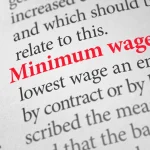This is part of a series of 3 ‘Back to Basics’ blogs to help employers talk to their employees about payroll, and to answer their initial questions about how their pay has been calculated. This blog focuses on national insurance – what it is, how it’s calculated, and who has to pay it.
National insurance is a deduction made to employees earnings, and is often seen as running along side tax deductions. However the calculation method, and the full scope of NI is often mis-understood.
National Insurance is calculated based on a code that is allocated to each employee. The most common NI code A is applied to employees aged 21 to state pension age. Employees under the age of 21 are allocated code M, whilst employees over state pension age are given code C. These are the most common codes used, however there are other codes that can be used, and these can be found on the Gov.UK website here.
Unlike tax, which is calculated using a ‘non-taxable allowance’ allocated to that employee spread throughout the year, NI is calculated based on each individual pay period, and is calculated by using contribution thresholds. These are:
- The Lower Earnings Limit (or LEL)
- The Primary Threshold (or PT)
- The Secondary Threshold (or ST)
- The Upper Earnings Limit (or UEL)
- The Upper Secondary Threshold (or UST) for under 21’s
- and the Apprentice Upper Secondary Threshold (or AUST) for under 25’s
The thresholds are set in the budget, in the same way that the non-taxable allowance is set, however the thresholds often don’t move annually in the same way as the non-taxable allowance.
Currently a percentage rate of zero is deducted against earnings up to the Primary Threshold. The PT is set at £162.00 per week, £702.00 per month or £8,424.00 per year. Beyond that, employees with an NI code of A or M have a deduction of 12% made to all earnings over the PT up to the UEL. For earnings beyond the UEL, currently £892.00 per week, £3,863.00 per month or £46,350.00 per year the deduction percentage reduces to 2%. An employee with an NI code of C is exempt from NI deductions, and this is explained by saying that they have a rate of zero percent applied.
When discussing NI, new employers are surprised to find that there is also ‘Employers NI’
Quite often employees are not aware that employers pay national insurance on their behalf, and this increases the cost of employing a person. Employers NI is calculated using the same thresholds, however is calculated at 13.8% from the PT onwards, and does not reduce to a lower percentage at any threshold. Interestingly, whilst an employee with a NI code of C is not subject to NI deductions, the employer still has to make NI contributions for the employee at 13.8%.
Employees under the age of 21 have NI deducted from their pay at the same rate as an employee over the age of 21, however in this circumstance the employer wins, and does not have to pay NI contributions on their earnings unless they are paid over the UST. This is currently set at the same threshold as the UEL. So there is a motivation to employ a young worker rather than a worker over state retirement age.
The final common code is H, which is allocated to an apprentice under the age of 25. An employee with a code of H is treaded the same as an employee with a code of A, but the employer does not pay employers NI until the employees earnings are above the UEL.
Whilst all of this can seem a little confusing the tables below will break down the earning thresholds and help group the codes together where treated the same.
NB These rates and thresholds apply to 2018/19 tax year only and may change in subsequent years
| Thresholds 2018/19 | ||||
| Class 1 NIC | Weekly Threshold | Monthly Threshold | Annual Threshold | |
| Lower Earnings Limit (LEL) | £116.00 | £503.00 | £6,032.00 | |
| Primary Threshold (PT) | £162.00 | £702.00 | £8,424.00 | |
| Secondary Threshold (ST) | £162.00 | £702.00 | £8,424.00 | |
| Upper Earnings Limit (UEL) | £892.00 | £3,863.00 | £46,350.00 | |
| Upper Secondary Threshold (UST) for under 21’s | £892.00 | £3,863.00 | £46,350.00 | |
| Apprentice Upper Secondary Threshold (AUST) for under 25’s | £892.00 | £3,863.00 | £46,350.00 | |
| Employee (primary contribution) | |||
| Category Letter | LEL to PT | Above PT to UEL | Above UEL |
| A, H (apprentice under 25), M (under 21) | 0% | 12% | 2% |
| J, Z (under 21 deferment) | 0% | 2% | 2% |
| B | 0% | 5.85% | 2% |
| C | nil | nil | nil |
| Employer (secondary contribution) | |||
| Category Letter | LEL to ST | Above ST to UEL/UST/AUST | Above UEL/UST/AUST |
| A, B, C and J | 0% | 13.8% | 13.8% |
| H (apprentice under 25), M (under21), Z (under 21 deferment) | 0% | 0% | 13.8% |
When looked at from this perspective, NI is much simpler to understand. And taking into account that most employees are on an A code for NI, things simplify still further.
However if you have any questions relating to NI, either about your own employment or about your employees, you can call Nadine in the PayrollAbility office today on 01384 92 90 20, or send an email to nadine@payrollability.co.uk.
We’re here to help and happy to take your call.
More information about NI can be found on the Gov.UK website.





